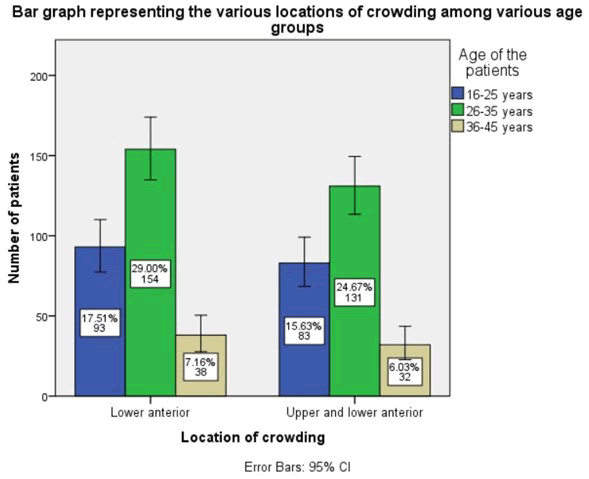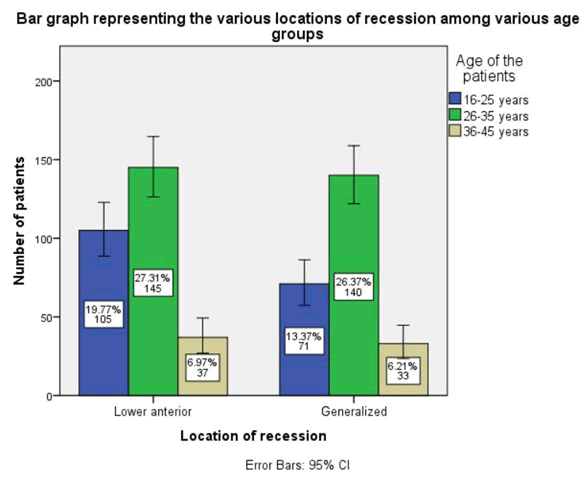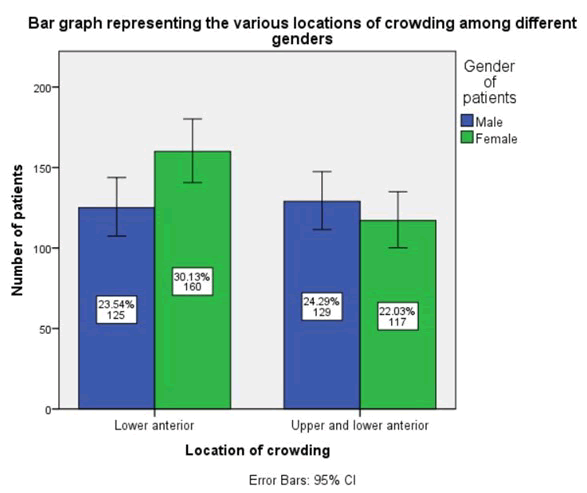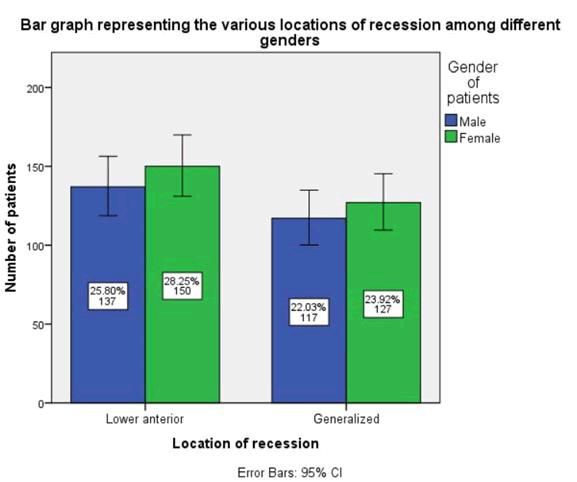Review Article - (2022) Volume 10, Issue 7
Retrospective Analysis Of Prevalence of Gingival Recession in Severe Crowding Cases Patients Reporting to a Teaching Hospital in Chennai
Remmiya Mary Varghese* and Prabhav Kumar Iyer
*Correspondence: Remmiya Mary Varghese, Department of Orthodontics, Saveetha Institute of Medical and Technical Science, Saveetha University, India, Email:
Abstract
Introduction: Crowding is one of the most common forms of malocclusion. It is usually seen in the anterior region. Crowding
mainly occurs in places where there is a discrepancy between the arch dimension and the size of the teeth there have been
reports of gingival recession due to malocclusion in the early stages of development, but there are only few extensive studies
about the topic. Hence, the aim of this study is to see the incidence of gingival recession in patients with severe crowding.
Materials and methods: Out of the 11687 patients who reported to a dental hospital that were diagnosed with crowding,
532 patients with severe crowding were selected. Details like their age, gender, the location of gingival recession and the
location of crowding were recorded, tabulated and imported to SPSS for statistical analysis.
Results: 47.8% of the participants were male and 52.2% of the participants were female. There was a significant association
between gender and location of crowding (p<0.05). There was no significance between age and crowding and age and
location of recession.
Conclusion: It can be concluded that the incidence of gingival recession is higher in females who have severe crowding. A
newer study with a population of more diverse participants can yield different results.
Keywords
Crowding, Innovative study, Orthodontic, Recession, MalocclusionIntroduction
Anterior crowding is one of the most common forms of malocclusion. The severity of crowding is influenced by various factors in the early and late stages of life. Factors like periodontal conditions, remodelling of bone and drift of tooth intensifies anterior crowding [1] and by relapse after orthodontic treatment [2,3]. Anterior teeth, especially lateral incisors and canines are most exposed to outside forces when compared to other teeth, which explains their durability [4]. This also explains why lower anterior teeth most commonly show gingival recession [5]. Commonly predisposing factors for gingival recession include malposition of tooth, tissue thickness, inadequate keratinized mucosa and pull of the frenum [6].
There are various articles which link improper orthodontic treatment to gingival recession. Tanaka et al suggests that, improper control of tooth movement can lead to formation of bone dehiscence which ultimately leads to gingival recession [7,8]. However, there are not a lot of studies which focus on gingival recession due to malocclusion. The studies which focus on this have relatively smaller population sizes for their results to hold any significance. Hence, the aim of this study is to see the incidence of gingival recession in patients with severe crowding.
Literature Review
Study design and setting
The study was performed in the form of a retrospective study in a university setting, thus the available data is of patients from a similar geographical area. The study was conducted using digital case records of 13231 patients who were diagnosed with anterior crowding. Ethical clearance to conduct the study was taken from the scientific review board of the hospital.
Sampling
Data of 11867 patients were reviewed. Only cases with severe crowding were considered, hence, the final count was 532. Simple random sampling was performed. An additional reviewer was enlisted to help cross verify the data using photographs. Incomplete case sheets were excluded.
Data Collection
An examiner analysed the records of the patients who reported to the university from June 2020 to April 2021. For the present study, inclusion criteria were data of patients with anterior crowding. Data obtained were age, gender, location of crowding, and areas affected by recession. All obtained data was tabulated into Microsoft Excel.
Statistical analysis
The data was tabulated and analysed with SPSS (Statistical Package for Social Sciences) for Windows, version 23.0 and results obtained were displayed in percentage and frequency. Chi Square test was used to test association between categorical variables where age and gender were the independent and dependent variables. Pearson Chi Square test was used for analysis where p value <0.05 was considered as statistically significant.
Results
Out of the 11867 patients who were diagnosed with crowding, 532 patients were included in the study. Out of these, 47.8% of the participants were male and 52.2% of the participants were female. The patients were divided into three age groups, namely 16-25 years: with 33.1% participants, 26-35 years: with 53.7% participants and 36-45 years: with 13.2% participants. The most common areas where crowding was seen were lower anterior and upper and lower anterior. The most common areas where recession was seen were lower anterior and generalized recession (Figures 1-4).
Figure 1: Bar graph representing the various locations of crowding among various age groups. The x axis displays the various locations of crowding and the y axis displays the number of patients. Blue displays the number of patients between the age of 16 and 25, green displays the number of patients between the age of 26 and 35 and beige displays the number of patients between the age of 36 and 45. P value was found to be 0.96 (p>0.05) which is statistically insignificant.
Figure 2: Bar graph representing the various locations of recession among various age groups. The X axis displays the various locations of recession and the Y axis displays the number of patients. Blue displays the number of patients between the age of 16 and 25, green displays the number of patients between the age of 26 and 35 and beige displays the number of patients between the age of 36 and 45. p value was found to be 0.18 (p>0.05) which is statistically insignificant.
Figure 3: Bar graph representing the various locations of crowding among various genders. The X axis displays the various locations of crowding and the Y axis displays the number of patients. Blue displays the male patients and green displays female patients. p value was found to be 0.04 (p<0.05) which is statistically significant.
Figure 4: Bar graph representing the various locations of recession among various genders. The X axis displays the various locations of recession and the Y axis displays the number of patients. Blue displays the male patients and green displays female patients. p value was found to be 0.96 (p<0.05) which is statistically insignificant.
Discussion
Our team has extensive knowledge and research experience that has translate into high quality publications [9-28]. Prevention of stress related reactions in the craniomandibular system can be done by orthodontic therapy. Crowding is one of the most common forms of malocclusions seen in the Indian population. It has a multifactorial etiology and factors like arch length, maturation of occlusion, balance of muscle, retention and loss of tooth may be linked to it [29]. In comprehensive orthodontic, recent studies have found that anterior crowding is not just limited to aesthetics but also causes functional issues [30].
Studies focussing on gingival recession due to crowding are scarce. Most studies focus on the incidence of gingival recession due to orthodontic treatment. Hence there were few articles to compare the current study with. In this study, it was found that there was a significant difference in the location of crowding among various genders, where females showed higher incidence of crowding than males in lower anterior. This is contradictory to the findings of a study done by Staufer where there was no relationship between recession and gender [3].
This study showed no relationship between age groups and recession. A study done by Richman et al also found no relation between age groups and recession [31]. But on the contrary, a study by Boymuradov showed that the incidence of gingival recession increased with an increase in age [32].
The progression of gingival recession is influenced by orthodontics even if it isn't caused by it. Orthodontic movement done keeping in mind the alveolar housing will retain bone in every aspect. If the tooth is pushed beyond this bony limit, formation of an underlying alveolar dehiscence will take place and the associated risk of progression will increase [33]. A lot of studies showed that orthodontic treatment to correct crowding was also an etiological factor in gingival recession. A study done by Kalinga showed that proper orthodontic planning can reduce the risk of gingival recession during orthodontic treatment [34].
The drawbacks of the current study are that the participants of the study belonged to a similar geographic location, which may have had an influence on the results. A more diverse study analysing the population belonging to a much more geographically diverse group could yield different results.
Conclusion
From the current study, it can be concluded that the incidence of gingival recession is more in females in the lower anterior region. There was no significant association between age group and the incidence of gingival recession. There is also no significant association between the location of crowding and age and the location of crowding and gender.
Funding
The present project is sponsored by
- Saveetha Institute of Medical and Technical Sciences
- Saveetha Dental College and Hospitals
- Balaji Transport Company
References
- Richardson M. Lower arch crowding in the young adult. Am J Orthod Dentofacial Orthop 1992; 101:132-137.
- Little RM, Riedel RA, Artun J. An evaluation of changes in mandibular anterior alignment from 10 to 20 years postretention. Am J Orthod Dentofacial Orthop 1988; 93:423-428.
- Staufer K, Landmesser H. Effects of crowding in the lower anterior segment--a risk evaluation depending upon the degree of crowding. J Orofac Orthop 2004; 65:13-25.
- Chace RS, Low SB. Survival characteristics of periodontally-involved teeth: a 40-year study. J Periodontol 1993; 64:701-705.
- Heasman PA, Ritchie M, Asuni A, et al. Gingival recession and root caries in the ageing population: a critical evaluation of treatments. J Clin Periodontol 2017; 44:178-193.
- Alamri AM, Alshammery HM, Almughamis MA, et al. Dental Recession Aetiology, Classification and Management. Arch Pharm Pract 2019; 10:28-31.
- Tanaka OM, Avila ALR, Silva GM, et al. The effects of orthodontic movement on a sub epithelial connective tissue graft in the treatment of gingival recession. J Contemp Dent Pract 2010; 11:073-079.
- Harris RJ. A Short-Term and Long-Term Comparison of Root Coverage with an Acellular Dermal Matrix and a Sub epithelial Graft. J Periodontol 2004; 75:734-743.
- Felicita AS. Orthodontic extrusion of Ellis Class VIII fracture of maxillary lateral incisor-The sling shot method. Saudi Dent J 2018; 30:265-269.
- Chandrasekar R, Chandrasekhar S, Sundari KKS, et al. Development and validation of a formula for objective assessment of cervical vertebral bone age. Prog Orthod 2020; 21:38.
- Arvind P TR, Jain RK. Skeletally anchored forsus fatigue resistant device for correction of Class II malocclusions-A systematic review and meta-analysis. Orthod Craniofac Res 2021; 24:52-61.
- Khan A, Verpoort F, Asiri AM, et al. Metal-Organic Frameworks for Chemical Reactions: From Organic Transformations to Energy Applications. Elsevier 2021.
[Crossref][Google Scholar][Indexed]
- Alam MK, Alfawzan AA, Haque S, et al. Sagittal Jaw Relationship of Different Types of Cleft and Non-cleft Individuals. Front Pediatr 2021; 9:651951.
- Marya A, Venugopal A. The Use of Technology in the Management of Orthodontic Treatment-Related Pain. Pain Res Manag 2021; 2021:5512031.
- Adel S, Zaher A, El Harouni N, et al. Robotic Applications in Orthodontics: Changing the Face of Contemporary Clinical Care. Biomed Res Int 2021; 2021:9954615.
- Sivakumar A, Nalabothu P, Thanh HN, et al. A Comparison of Craniofacial Characteristics between Two Different Adult Populations with Class II Malocclusion-A Cross-Sectional Retrospective Study. Biology 2021; 10.
- Venugopal A, Vaid N, Bowman SJ. Outstanding, yet redundant? After all, you may be another Choluteca Bridge! Semin Orthod 2021; 27:53-56.
- Gopalakrishnan U, Felicita AS, Mahendra L, et al. Assessing the Potential Association Between Microbes and Corrosion of Intra-Oral Metallic Alloy-Based Dental Appliances Through a Systematic Review of the Literature. Front Bioeng Biotechnol 2021; 9:154.
- Venugopal A, Vaid N, Bowman SJ. The quagmire of collegiality vs competitiveness. Am J Orthod Dentofacial Orthop 2021; 159:553-555.
- Marya A, Karobari MI, Selvaraj S, et al. Risk Perception of SARS-CoV-2 Infection and Implementation of Various Protective Measures by Dentists Across Various Countries. Int J Environ Res Public Health 2021; 18.
- Ramesh A, Varghese S, Jayakumar ND, et al. Comparative estimation of sulfiredoxin levels between chronic periodontitis and healthy patients-A case-control study. J Periodontol 2018; 89:1241-1248.
- Joseph B, Prasanth CS. Is photodynamic therapy a viable antiviral weapon against COVID-19 in dentistry? Oral Surg Oral Med Oral Pathol Oral Radiol 2021; 132:118-119.
- Ezhilarasan D, Apoorva VS, Ashok Vardhan N. Syzygium cumini extract induced reactive oxygen species-mediated apoptosis in human oral squamous carcinoma cells. J Oral Pathol Med 2019; 48:115-121.
- Duraisamy R, Krishnan CS, Ramasubramanian H, et al. Compatibility of Nonoriginal Abutments With Implants: Evaluation of Microgap at the Implant-Abutment Interface, With Original and Nonoriginal Abutments. Implant Dent 2019; 28:289-295.
- Gothandam K, Ganesan VS, Ayyasamy T, et al. Antioxidant potential of theaflavin ameliorates the activities of key enzymes of glucose metabolism in high fat diet and streptozotocin-induced diabetic rats. Redox Rep 2019; 24:41-50.
- Ezhilarasan D. Hepatotoxic potentials of methotrexate: Understanding the possible toxicological molecular mechanisms. Toxicology 2021; 458:152840.
- Preethi KA, Auxzilia Preethi K, Sekar D. Dietary micro RNAs: Current status and perspective in food science. J Food Biochem 2021; 45.
- Pramustika A, Widayati R. Treatment of a Class I Malocclusion with Severe Crowding using Passive Self-Ligating Brackets. J Dent Indonesia 2020; 27:109-113.
- Abboud M, Gruner M, Koeck B. Anterior Crowding-Just an Esthetic Problem? J Orofac Orthop 2002; 63:264-273.
- Richman C. Is gingival recession a consequence of an orthodontic tooth size and/or tooth position discrepancy? "A paradigm shift." Compend Contin Educ Dent 2011; 32:73-79.
- Boymuradov sa, sabirov ee. Frequency and development causes of gingival recession in different age groups on the example of yunusabad district, tashkent. Cent Asian J Med Sci 2019; 2019:141-154.
- Baker P. Gingival Recession Causes and Management. Prim Dent J 2019; 8:40-47.
- Kalina E, Zadurska M, Gorski B. Postorthodontic lower incisor and canine inclination and labial gingival recession in adult patients. J Orofac Orthop 2021; 82:246-256.
- Varghese RM, Subramanian AK, Sreenivasagan S. Comparison of dentoskeletal changes in skeletal class II cases using two different fixed functional appliances: Forsus fatigue resistant device and powerscope class II correctorâ??A clinical study. J Int Oral Health 2021; 13: 234.
Author Info
Remmiya Mary Varghese* and Prabhav Kumar Iyer
Department of Orthodontics, Saveetha Institute of Medical and Technical Science, Saveetha University, IndiaReceived: 25-Apr-2022, Manuscript No. JRMDS-22-47314; , Pre QC No. JRMDS-22-47314; Editor assigned: 27-Apr-2022, Pre QC No. JRMDS-22-47314; Reviewed: 11-May-2022, QC No. JRMDS-22-47314; Revised: 25-Jun-2022, Manuscript No. JRMDS-22-47314; Published: 02-Jul-2022




